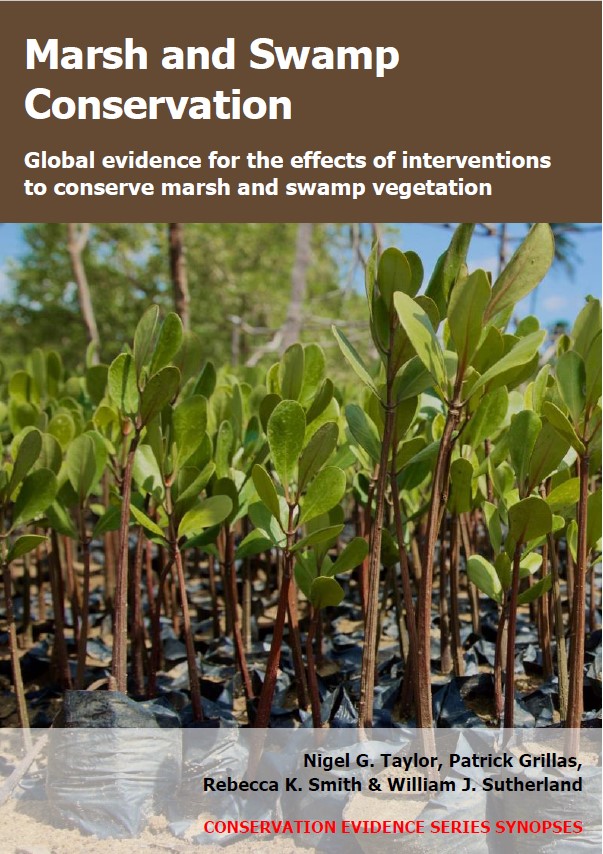Actions to conserve biodiversity
We have summarised evidence from the scientific literature about the effects of actions to conserve wildlife and ecosystems.
Review the evidence from the studies
Not sure what Actions are? Read a brief description.
Search for evidence
e.g. "frogs chytrid"
441 Actions found
Refine
Hide
441 Actions found
Download Actions
| 0 selected |
|
Order results by:
| Action | Effectiveness | Studies | Category | |
|---|---|---|---|---|
|
Create mounds or hollows before planting trees/shrubs: freshwater wetlands Action Link |
Likely to be beneficial | 3 |
|
|
|
Add upland topsoil before/after planting non-woody plants: freshwater wetlands Action Link |
Unknown effectiveness (limited evidence) | 3 |
|
|
|
Add lime or similar chemicals before/after planting non-woody plants: brackish/saline wetlands Action Link |
Unknown effectiveness (limited evidence) | 3 |
|
|
|
Remove vegetation that could compete with planted non-woody plants: freshwater wetlands Action Link |
Unknown effectiveness (limited evidence) | 3 |
|
|
|
Physically damage seeds of non-woody plants before sowing: freshwater wetlands Action Link |
Unknown effectiveness (limited evidence) | 3 |
|
|
|
Provide general protection for marshes or swamps Action Link |
Likely to be beneficial | 3 |
|
|
|
Change season/timing of livestock grazing: brackish/salt marshes Action Link |
Likely to be beneficial | 2 |
|
|
|
Plug/dam canals or trenches: brackish/salt marshes Action Link |
Likely to be beneficial | 2 |
|
|
|
Lower water level to restore degraded freshwater marshes Action Link |
Unknown effectiveness (limited evidence) | 2 |
|
|
|
Raise water level to restore degraded brackish/salt marshes Action Link |
Likely to be beneficial | 2 |
|
|
|
Actively manage water level: freshwater swamps Action Link |
Likely to be beneficial | 2 |
|
|
|
Use prescribed fire to maintain or restore disturbance: freshwater swamps Action Link |
Unknown effectiveness (limited evidence) | 2 |
|
|
|
Physically damage problematic plants: freshwater swamps Action Link |
Unknown effectiveness (limited evidence) | 2 |
|
|
|
Use cutting/mowing to control problematic herbaceous plants: freshwater swamps Action Link |
Unknown effectiveness (limited evidence) | 2 |
|
|
|
Use cutting to control problematic large trees/shrubs: freshwater marshes Action Link |
Unknown effectiveness (limited evidence) | 2 |
|
|
|
Control populations of wild vertebrates: freshwater marshes Action Link |
Unknown effectiveness (limited evidence) | 2 |
|
|
|
Remove debris from brackish/salt marshes Action Link |
Likely to be beneficial | 2 |
|
|
|
Cut or burn oil-contaminated vegetation: brackish/salt marshes Action Link |
Likely to be ineffective or harmful | 2 |
|
|
|
Raise water level to restore/create brackish/salt marshes from other land uses Action Link |
Unknown effectiveness (limited evidence) | 2 |
|
|
|
Lower water level to restore/create freshwater marshes from other land uses Action Link |
Unknown effectiveness (limited evidence) | 2 |
|
|
|
Raise water level to restore/create freshwater swamps from other land uses Action Link |
Unknown effectiveness (limited evidence) | 2 |
|
|
|
Facilitate tidal exchange to restore/create brackish/saline swamps from other land uses Action Link |
Unknown effectiveness (limited evidence) | 2 |
|
|
|
Reprofile/relandscape: freshwater swamps Action Link |
Unknown effectiveness (limited evidence) | 2 |
|
|
|
Disturb soil/sediment surface: freshwater marshes Action Link |
Unknown effectiveness (limited evidence) | 2 |
|
|
|
Deposit soil/sediment to form physical structure of freshwater marshes Action Link |
Unknown effectiveness (limited evidence) | 2 |
|
Download Actions
| 0 selected |
|

Marsh and Swamp Conservation - Published 2021
Marsh and Swamp Synopsis
Watch this search
If you are familiar with RSS feeds, please click the button below to retrieve the feed URL:
RSS feed for this searchIf you are unfamiliar with RSS feeds, we would suggest reading this BBC article.
Unfortunately, due to the number of feeds we have available, we cannot provide e-mail updates. However, you could use tools such as Feed My Inbox to do this for you.
What are 'Individual studies' and 'Actions'?
Individual studies
An individual study is a summary of a specific scientific study, usually taken from a scientific journal, but also from other resources such as reports. It tells you the background context, the action(s) taken and their consequences.
If you want more detail please look at the original reference.
Actions
Each action page focuses on a particular action you could take to benefit wildlife or ecosystems.
It contains brief (150-200 word) descriptions of relevant studies (context, action(s) taken and their consequences) and one or more key messages.
Key messages show the extent and main conclusions of the available evidence. Using links within key messages, you can look at the paragraphs describing each study to get more detail. Each paragraph allows you to assess the quality of the evidence and how relevant it is to your situation.
Where we found no evidence, we have been unable to assess whether or not an intervention is effective or has any harmful impacts.





)_2023.JPG)














